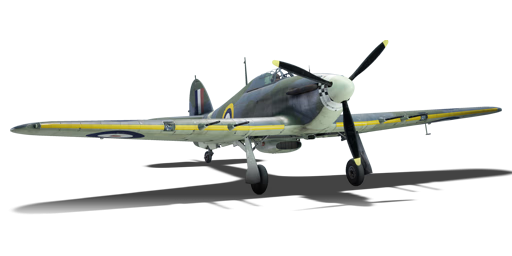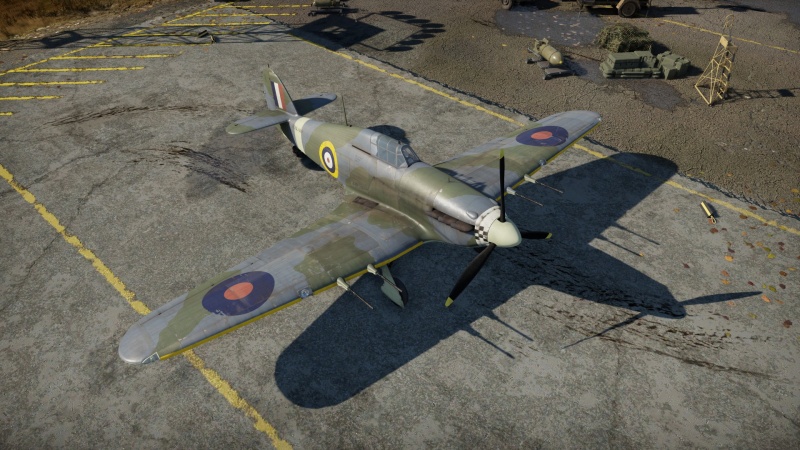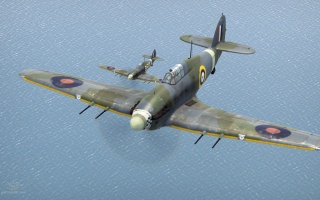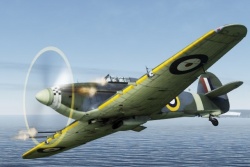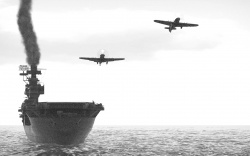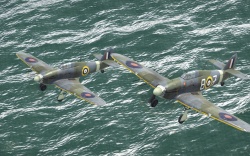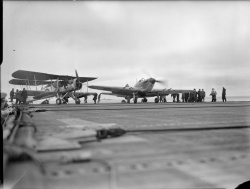Sea Hurricane Mk IC
| This page is about the British naval fighter Sea Hurricane Mk IC. For the other navalised Hurricane, see Sea Hurricane Mk IB. For other versions, see Hurricane (Family). |
Contents
Description
The Sea Hurricane Mk IC is a rank II British naval fighter with a battle rating of 3.3 (AB/SB) and 3.0 (RB). It was introduced in Update 1.49 "Weapons of Victory".
The Hurricane is not a great climber and its optimal operating altitude is in the medium range. Between 4 and 5 km should suffice most combat situations. As a rule of thumb, it is advisable to gain some altitude in the initial stages of the battle. This will help with cruise speed and give you some altitude to trade in order to pick up additional speed. With the relatively low maximum speed of the Hurricane, extended chases are not practical though a quick dive on a bogey can provide a short-lived closure into firing range.
Offensively, the Hurricane's greatest assets are a very good turn-rate and big firepower. The aircraft's weaknesses are in anything extended, such as a chase or escape manoeuvres. Hurricanes are mostly flown as turn-fighters. Using as many energy conserving manoeuvres as you can, turn-fight opponents to get into position to take quick snapshots at short range with the four Hispanos. This is really effective and it can't be stressed enough that you can take out any plane in the game with only a half second burst. Being slow isn't great because of the defensive liabilities but you should be able to turn with almost anything as speeds bleed off. Don't get overly greedy with chasing people in dives as they tend to lead to more extended chases which won't favour you.
Defensively you don't have that many options and typically you'll end up in a sort of turning defence. You can't really run and diving away isn't going to help you in most cases. Your turn rate can be very high though, placing the enemy in a poor offensive situation. If you are alert, you can basically force your enemy to face a head-on option or break off the attack. It is not a great option though as it basically assures the demise of you both unless one of you is a terrible shot. Junior pilots see this as a prime spot, while veteran pilots will tend to avoid, so it is risky. If you can trick an enemy into slowing down in an inferior turning aircraft though, which are most planes in the game, then you may be able to win angles quite quickly in a sustained turn-fight.
It is most important to consider that the Sea Hurricane Mk.IC suffers much from its high battle-rating in general. The Hurricane seems to be misplaced within War Thunder, as it is ranked equal to the Bristol Beaufighter Mk VIc in Realistic battles, and is ranked equal to the Beaufighter Mk X in Arcade battles. In comparison: the Beaufighter Mk X has the same four 20 mm Hispano Mk II cannons, but they are mounted in the centre fuselage, allowing for far better accuracy. Furthermore, the Mk X is armed with six additional .303 (7.7 mm) Browning machine guns - and that does not even consider the better performance of the Beaufighter design. In Realistic battles, the aircraft is an easy target for Boom & Zoom opponents, as you will become visible to the enemy at around 8 km distance. Novice pilots in particular will have a very hard time surviving. In Simulator battles, the aircraft functions better, as most players will be tempted to turn-fight, in which the Sea Hurricane's turn-time and firepower make it a deadly aircraft.
However, as with all machines in War Thunder, even the Hawker Sea Hurricane Mk IC can become a very deadly tool in the hands of a skilled pilot.
The Hawker Sea Hurricane Mk IC is a naval fighter aircraft. It has a higher battle rating than the other variants of the Hurricane in War Thunder. As a rank II fighter, it packs a very heavy punch with its four cannons and is able to function as a fighter or attacker - although under-wing armament is not available to this Hurricane model. Being the naval version of the Hurricane, the aircraft is ready for carrier operations - which is recognizable by the tail-hook on the aircraft.[1]
The four Hispano Mk II cannons give the Sea Hurricane Mk IC massive firepower. A small burst that scores a few hits on a bogey is often enough to shred the enemy in seconds. Granted that the pilot gets into a fairly close distance to their target (200 m - 400 m is optimal) and firing at gun convergence. However, the four cannons can burn through ammo very quickly, which can lead to constant reload in Arcade Battles and ammunition depletion in Realistic and Simulator Battles if the pilot doesn't manage his fire.
Unfortunately, the Sea Hurricane Mk IC is not able to carry any under-wing armament. This means that the aircraft does not truly function as a fighter-bomber. The attacker role can be fulfilled, though the ground-attack munitions for the Hispanos do not have enough power to destroy stronger ground targets.
General info
Flight performance
The Sea Hurricane Mk IC's flight performance is extremely similar to that of the Hurricane Mk I/L. It has rather good manoeuvrability and can win a dogfight or a head-on easily because of its strong structure and its four Hispano Mk.II cannons.
| Characteristics | Max Speed (km/h at 3,962 m) |
Max altitude (metres) |
Turn time (seconds) |
Rate of climb (metres/second) |
Take-off run (metres) | |||
|---|---|---|---|---|---|---|---|---|
| AB | RB | AB | RB | AB | RB | |||
| Stock | 480 | 462 | 11000 | 18.1 | 18.9 | 3.5 | 3.5 | 300 |
| Upgraded | 542 | 509 | 16.4 | 17.0 | 14.6 | 8.0 | ||
Details
| Features | ||||
|---|---|---|---|---|
| Combat flaps | Take-off flaps | Landing flaps | Air brakes | Arrestor gear |
| ✓ | ✓ | ✓ | X | ✓ |
| Limits | ||||||
|---|---|---|---|---|---|---|
| Wings (km/h) | Gear (km/h) | Flaps (km/h) | Max Static G | |||
| Combat | Take-off | Landing | + | - | ||
| 660 | 320 | 268 | 246 | 202 | ~10 | ~6 |
| Optimal velocities (km/h) | |||
|---|---|---|---|
| Ailerons | Rudder | Elevators | Radiator |
| < 370 | < 250 | < 380 | > 410 |
| Compressor (RB/SB) | ||
|---|---|---|
| Setting 1 | ||
| Optimal altitude | 100% Engine power | WEP Engine power |
| 4,953 m | 1,030 hp | 1,355 hp |
Survivability and armour
- 6.35 mm Steel - Armour plating in front of cockpit control panel
- 12.7 mm Steel - Armour plating behind pilot's seat and headrest
- 38 mm Bulletproof glass - Armoured windscreen
Modifications and economy
Armaments
Offensive armament
The Sea Hurricane Mk IC is armed with:
- 4 x 20 mm Hispano Mk.II cannons, wing-mounted (125 rpg = 500 total)
Usage in battles
The aircraft can fulfil two roles: it either can take the role of a fighter or an attack aircraft. It excels as an interceptor (or bomber-hunter in War Thunder language).
As a fighter, its flight characteristics and performance are only barely sufficient for the fighter role within its rank. Although the Hurricane IIC's speed and more importantly turn time are considerable lower than the Spitfire and its other Hurricane relatives, it's still slightly more nimble and quicker than the Mark IIB. However, it faces considerable more deadly and able opponents during battles so it lacks somewhat in dogfighting capability. Nonetheless, it remains a forgiving aircraft and retains the friendly characteristics of the Hurricane family. Roll rate is still rather slow. With its forward centre of gravity, the Mark IC is inclined to climb at full power or has a nose-down angle of attack in level flight. The plane is fairly easy to manoeuvre at all speeds, but is less able to out-manoeuvre other planes at its level: the Sea Hurricane Mk IC has considerable tougher enemies to fight.
With its four 20 mm Hispano Mark II cannons, the Sea Hurricane IC is well suited for the fighter role as it packs a tremendous punch at this rank. With four cannons, the Mark IC carries the most powerful armament on a Hurricane in the game, with a hard-hitting one-second burst mass of 5.17 kg/s. It is this firepower that makes the Mark IC an aircraft that every opponent should respect, though not typically fear, as it can do a knock-out in an instant but is also hampered by the outclassed design. In the right hands however, it can rip planes apart instantaneously. The Hispanos are deadly at snapshots, deflection shots, tracking shots and head-on shots -given you are able to score some hits, where some are enough to down an opponent. The calibre of the weapons come at a price though: with only 125 rounds per gun, ammunition can be expended rather quickly in realistic battles and simulator battles. Trigger discipline is key here and will benefit both ammunition conservation and fire accuracy. Even with the heavy Hispano cannon armament, the Hurricane remains a very stable gun-platform. The cannons can be loaded with various belts, once researched, with both dedicated ground and air attack compositions. This makes the Hawker Sea Hurricane Mk IC suitable both as a fighter and an attack aircraft. However, as it lacks under-wing armament such as bombs or rockets, it lacks the real ground-pounding power of its War Thunder sibling, the Hurricane Mk IIB/Trop.
The aircraft can fulfil various roles, though it does not particularly excel as a fighter or attack aircraft. What it does excel in, is the role of interceptor or 'bomber-hunter'. The mass of its firepower is well suited to break most enemy bombers. Low and medium altitude bombers are an easy catch. However, high-flying bombers will be tough to catch as the Hurricane generally lacks speed and climbing ability.
However, the disadvantages of the Hurricane design are also present in the Mark IC: the biggest concern being its rather fragile engine and airframe. Its soft skin and little protection means the Mark IIB can't take too much damage before it takes on critical damage. Once the aircraft is damaged, the plane often loses controllability, making survival far harder, as manoeuvrability is key for the British aircraft.
Specific enemies worth noting
Fighters
- Bf 109s & Fw 190s - Although the latter are still not commonly encountered at its BR, both the 109 and the 190 pose a large threat due to the excellent firepower and great boom-and-zoom characteristics. Whilst German pilots that allow themselves to lured in turn fighting can be quickly destroyed, the boom-and-zoom tactics are hard to counter. The Hurricane packs a punch but can still be defeated by the German cannon power in a head-on engagement. It's more advisable to evade a head-on attack and try to engage after a quick turn. The Mark IC pilot should avoid boom and zoom attacks and try to lure the opponent into a turn to follow or a complete turn fight in order to get a gun solution on the target. The Sea Hurricane IC isn't fast enough nor has the high-altitude performance its German opponents have, so don't think about winning such a race in the long run.
- Bf 110s - The Bf 110s are now no longer a big concern. The most dangerous scenarios remain head-on and boom-and-zoom attacks. The Bf 110 packs one of the biggest punches at its rank, though your four Hispanos outclass the German firepower. It is rather slow in turning and is a big target though, so if you do get a angle within convergence range, the Bf 110 can be taken out quite easily.
- I-153P & I-16 type 28 - Although the Sea Hurricane Mk IC never had to fight Russians in real life, War Thunder does bring this challenge. In general, the Russians have a major advantage here. Being more manoeuvrable and having good firepower available, the I-153 and I-16 can be a tough nut to crack. Avoid turn fights with these aircraft. You have the advantage of speed, but only marginally so. Avoid getting too close, unless you are leading the target. Never engage multiple Russian bogeys when lacking support by other teammates.
- Yak-9s: The Yak-9 sits somewhere between the agile I-153s & I-16s and the more advanced La-5s. The Yaks surpass the Hurricane in turn time and speed. On top of being superior in that field, the Yaks also bring a big punch to the battle. Unless you have a great ambush opportunity in your Sea Hurricane Mk IC, avoid the Yak-9 as an opponent.
- La-5s: Although the La-5s are a very tough opponent, the La-5s do not match the Hurricane's turn speed. Ergo: turn-fighting is your best option here. Avoid being caught in a boom-and-zoom situation as a target: the La-5 is fast, has great energy conservation and has a deadly punch with its two ShVAK 20 mm cannons. Try to catch the La-5s below you, where you have the advantage of energy. The La-5s do not carry a lot of ammunition, so making them expend their rounds is a good albeit very dangerous tactic.
- American fighters - The US fighter aircraft at this rank are faster than the Sea Hurricane Mk IC - not just a bit, but really fast (the P-47 will do almost 200 km/h more than your Mk IC). These opponents also often approach your aircraft capabilities in terms of firepower. Turn fighting is key here - avoid being caught in boom-and-zoom fights with your speedier American opponents, as they will race past you while they take snapshots with their impressive firepower.
Bombers
- For all bomber targets you may encounter the tactics are bound by two main considerations: lack of ammunition and vulnerability of the Sea Hurricane IC. Engaging targets with speed advantage and firing within the convergence zone allows you to really do damage. The Mark IC is an excellent interceptor or bomber hunter, though in the hands of a novice pilot this will likely mean many return trips to base to reload those guns. Get accurate and await a powerful shooting solution.
Manual Engine Control
| MEC elements | ||||||
|---|---|---|---|---|---|---|
| Mixer | Pitch | Radiator | Supercharger | Turbocharger | ||
| Oil | Water | Type | ||||
| Controllable | Controllable Not auto controlled |
Not controllable Not auto controlled |
Controllable Auto control available |
Combined | Not controllable 1 gear |
Not controllable |
Pros and cons
Pros:
- Good manoeuvrability
- Good handling characteristics / easy to fly
- Excellent over-the-nose visibility ensures easy tracking and leading in cockpit view
- Is a stable gun platform with very smooth handling with simulator controls
- Extreme firepower with 4 x 20 mm cannons
- The cannons equipped with a Ground Targets belt are effective in a ground attack role
Cons:
- Low structural strength / fragile engine and airframe
- Low ammunition capacity
- Low maximum speed & acceleration / doesn't intercept or chase well
- Tough matchmaking at its BR / hard aircraft for novice pilots
History
As the Fleet Air Arm (FAA) was very slow on developing a modern ship-borne fighter in the interbellum, the Gloster Gladiator was adapted to the role in 1938. However, the situation in Norway in 1940 made it painfully clear that the RAF was not able to support expeditionary operations from bases in the United Kingdom and the Gladiator was very much obsolete. To worsen the crisis, Britain had lost HMS Courageous and Glorious in the failed Norwegian campaign and had no quick way to replace the carriers. During the campaign however, valuable experience was gained with Hurricanes of RAF No. 46 Squadron, as the aircraft proved that using it on a carrier was possible during the Squadrons transfer to Norway. A solution was needed.[2]
The FAA had already started adapting ex-RAF Hawker Hurricanes from land use to naval use in 1941, when the first Hawker Sea Hurricane IA's appeared.[3] 50 aircraft were supplied by Fighter Command, another 50 were supplied from Canadian production. With Britain desperately finding means to tip the Battle for the Atlantic in its favour, drastic measures were taken. As land-based maritime patrol and fighter aircraft could not completely cover the Atlantic yet, the Sea Hurricane would provide a temporary solution. The Mark IA's were fitted with catapult spools and could be launched with a rocket-propelled catapult from dedicated vessels. First known as Fighter Catapult ships, operated by the Royal Navy, the ships would be operated by the Merchant Navy from November 1941 and be known as Catapult Aircraft Merchant (CAM) ships. The Hurricanes would become known as "Hurricats" or "Catafighters". When a convoy was threatened or shadowed by German aircraft, the FAA pilot would launch and engage. Between June and October 1941, ten launches were made whilst escorting Atlantic convoys. The result was one Fw 200 Condor destroyed, two more damaged and others driven away. As the FC ships were replaced by CAM ships, the FAA pilots were swapped with volunteer RAF personnel. Between November 1941 and July 1943, when the CAM operations ceased, six German aircraft were shot down and two were damaged.[3] Without an airbase to return to or carriers to recover at, the pilots would ditch the aircraft close to the convoy, to be picked up from the frigid waters. Although these operations clearly involved considerable risk, only two pilots were lost at sea.[4]
Meanwhile, the Hawker Sea Hurricane Mark IB, equipped with an arrestor hook, had been produced and entered combat service in July 1941. The Sea Hurricane Mk IC followed in January 1942. Although the FAA got a dedicated maritime Sea Hurricane with the Mark II, at least 185 Sea Hurricanes were navalised RAF Mk IIBs and IICs: called Hooked Hurricanes rather than Sea Hurricanes.[3][4] Now the FAA had aircraft that could be operated from its steadily increasing number of escort and fleet aircraft carriers. The design of the Hurricane suited the harsh naval environment far better than the nimble Spitfire. With its rugged design, wide-track landing gear and docile flight characteristics the aircraft could better handle tough carrier operations.[5]
The Sea Hurricane equipped No. 880 Squadron on HMS Indomitable took part in the Allied invasion of Madagascar in May 1942, though saw little action. Major action with the Sea Hurricane occurred during the convoy escort to Malta in June 1942; where Sea Hurricanes of No. 801 Squadron on HMS Eagle claimed six Italian aircraft during Operation Harpoon. In August of that year, the better-known Operation Pedestal saw a convoy to Malta fight its way through the Mediterranean, with four Sea Hurricane squadrons taking part in the engagement: No. 800 & No. 880 on HMS Indomitable, No. 801 on HMS Eagle and No. 885 on HMS Victorious. During this confrontation, Lieutenant R. Cork of 880 Squadron shot down five aircraft on the 13th August for a total of six planes in two days. Other pilots claimed 15 more aircraft during the engagement.[4]
The convoys to Russia also received support from Sea Hurricanes when in September 1941 aircraft from No. 802 and No. 883 Squadrons on HMS Avenger claimed five kills during convoy PQ19 to North Russia. Although four Hurricanes were lost, only one pilot was killed and the convoy suffered little loss.
The last big action for Sea Hurricanes occurred during Operation Torch, the landings in North Africa, on 8 November 1942. Two carrier forces covered the landings at Oran and Algiers: seven carriers took 14 naval fighter squadrons into battle, of which No. 802 and No. 883 Squadrons on HMS Avenger, 804 and 891 on HMS Dasher and 800 on HMS Biter were equipped with Sea Hurricanes. Interestingly, the aircraft wore US star roundels to identify them as American assets. No. 800 Squadron achieved the greatest success of the naval squadrons as it claimed the destruction of several French Dewoitine D.520's at no loss. However, due to the inexperience of many other pilots of the British carrier squadrons, many Sea Hurricanes were lost or damaged at recovery.[3]
After Operation Torch, the front line use of Sea Hurricanes diminished as more potent fighters, such as Seafires, Wildcats and Hellcats became available. Nonetheless the Sea Hurricane continued its service in escort to convoys to Russia and on the Atlantic. On 26 May 1944 No. 835 Squadron claimed the last Sea Hurricane victories: two Junkers Ju 290s destroyed on a convoy run to North Russia. The final sorties were flown by Sea Hurricanes of No. 824 Squadron, before re-equipping with Wildcats during the summer of 1944, thus ending the three-year service of the Sea Hurricane during World War II.[3] Although the achievements of the Sea Hurricane were humbler than its land-based Hurricane sibling, the aircraft and its crew provided much needed protection to convoys when no other means were available to protect this lifeline to the British Isles. The aircraft and pilots provided naval air power for Britain in a time when means were limited and German dominance was not yet broken. A job that was crucial, though is often overlooked.
Media
- Skins
- Images
- Videos
See also
Links to the articles on the War Thunder Wiki that you think will be useful for the reader, for example:
- reference to the series of the aircraft;
- links to approximate analogues of other nations and research trees.
External links
References
- ↑ [Wikipedia] Hawker Hurricane variants, The Hurricane has known a long line of development during World War II, which has resulted in a great many aircraft designations. The designation Sea Hurricane Mk IC can be confusing, as its cannon-armed land-based relative is the Hurricane Mk IIC. No land-based Mk I series aircraft ever received the four cannon armament. The naval versions thus follow a different line of designation.
- ↑ The Hawker Hurricane: A Comprehensive Guide for the Modeller, Franks (1999), "The Hawker Hurricane: A Comprehensive Guide for the Modeller", SAM Publications, ISBN10: 095334651X
- ↑ 3.0 3.1 3.2 3.3 3.4 Hawker Hurricane Mk. I/IV in Royal Air Force & Foreign Service Shores & Ward (1971), "Hawker Hurricane Mk.I/IV in Royal Air Force & Foreign Service", P. 11/12, Osprey Publishing, SBN 85045 029 2.
- ↑ 4.0 4.1 4.2 Hurricane Aces 1941–45, Weal & Thomas (2003),"Aircraft of the Aces 57: Hurricane Aces 1941–45", Osprey Publishing, ISBN 9781841766102.
- ↑ Hawker Hurricane Owner's Workshop Manual, Blackah & Lowe (2010) "Hawker Hurricane Owner's Workshop Manual: An Insight into Owning, Restoring, Servicing and Flying Britain's Classic World War II Fighter", JH Haynes & Co Ltd, ISBN-10: 1844259552
| Hawker Aircraft Limited | |
|---|---|
| Biplane fighters | |
| Fury | Fury Mk I · Fury Mk II |
| Nimrod | Nimrod Mk I · Nimrod Mk II |
| Scout plane | Osprey Mk IV |
| Piston fighters | |
| Hurricane | Hurricane Mk I/L · Hurricane Mk.I/L FAA M · Sea Hurricane Mk IB · Sea Hurricane Mk IC · Hurricane Mk IIB/Trop · Hurricane Mk IV |
| Typhoon | Typhoon Mk Ia · Typhoon Mk Ib · Typhoon Mk Ib/L |
| Tempest | Tempest Mk V · Tempest Mk V (Vickers P) · Tempest Mk II |
| Fury | Sea Fury FB 11 |
| Jet fighters | |
| Hunter | Hunter F.1 · Hunter F.6 · Hunter FGA.9 · ◌Hunter F.58 |
| Sea Hawk | Sea Hawk FGA.6 |
| Harrier | Harrier GR.1 · Harrier GR.3 |
| Export | ▄Hurricane Mk I/L · ▂Hurricane Mk IIB · J34 · ◄Sea Hawk Mk.100 · AV-8A · AV-8C |
| Captured | ▀Tempest Mk V |


